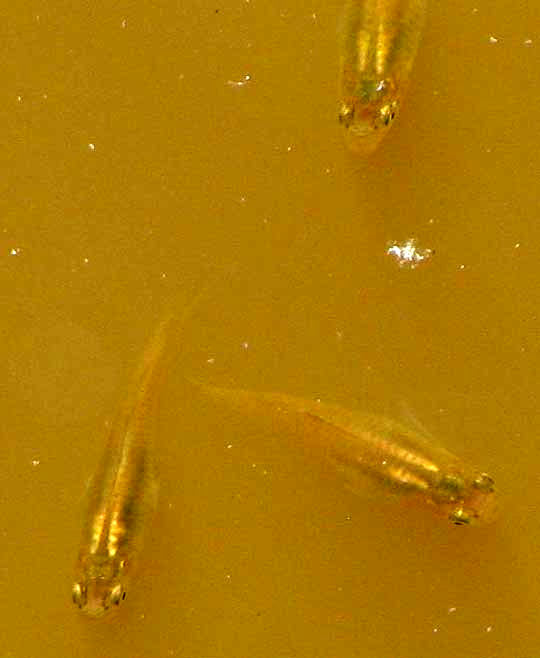Excerpts from Jim Conrad's
Naturalist Newsletter
from the May 13, 20012 Newsletter issued from the woods of the Loess Hill Region a few miles east of Natchez, Mississippi, USA
WESTERN MOSQUITOFISH
In the same muddy ditch-water as the water snake hundreds of Western Mosquitofish, GAMBUSIA AFFINIS, swam nonchalantly with their flattish foreheads flush with the water's undersurface, and their silvery twin swim bladders clearly visible inside semi-transparent bodies, as shown below.

As a kid in Kentucky on a farm surrounded by drainage ditches that, before obsessive channelization and overuse of pesticides in the fields, teemed with wildlife, on Saturday mornings I used to sit beside the gravel road selling "minnows" to fishermen. Later I learned that the word minnow applies to any number of small baitfish, and that I'd really been selling Western Mosquitofish.
I know that what we have here are the Western Mosquitofish instead of the look-alike Eastern species because Ross & Brenneman write in their 2001 book The Inland Fishes of Mississippi, partially available on Google Books pages, mosquitofish populations east of Mobile Bay are Eastern Mosquitofish, Gambusia holbrooki, while those west of the bay are Westerns. The two mosquitofish species are native to fresh and low-salinity waters from New Jersey to central Mexico, and in the US up the Mississippi drainage as far inland as Illinois. They've been introduced into many parts of the world, though, especially for mosquito control, despite studies showing that typically they're no more effective at eating mosquito larvae than local native mosquito-larvae-eating species.
But mosquitofish do eat their share of mosquito larvae, along with other small aquatic animals and detritus. It's been shown that they can eat the equivalent of up to 75% of their bodyweight each day.
At least one specialist suggests that the Western Mosquitofish may be the most numerous freshwater fish in the whole world.
One reason mosquitofish are so common is that they're so prolific. Females typically brood around 60 young, but large individuals may produce 300 or more. Females born early in the breeding season reach sexual maturity in 21-23 days when they're as little as 2/5ths inch long (10mm). Males mature in about a month. Mosquitofish are livebearers with internal fertilization, and females can store sperm so that multiple broods can be produced from a single mating.
However, few mosquitofish in the wild survive beyond one year, with the maximum life span for females about 1.5 years. Male life spans are much shorter.